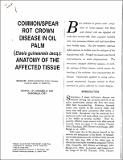Mostrar el registro sencillo del ítem
Common/spear rot crown disease in oil palm (Elaeis guineensis Jacq.): anatomy of the affected tissue
| dc.creator | Monge Pérez, José Eladio | |
| dc.creator | Vásquez Morera, Nelly | |
| dc.creator | Chinchilla, Carlos Manuel | |
| dc.date.accessioned | 2019-01-24T16:59:10Z | |
| dc.date.available | 2019-01-24T16:59:10Z | |
| dc.date.issued | 1994-12 | |
| dc.identifier.citation | http://jopr.mpob.gov.my/commonspear-rot-crown-disease-in-oil-palm-elaeis-guineensis-jacq-anatomy-of-the-affected-tissue/ | |
| dc.identifier.issn | 1511-2780 | |
| dc.identifier.uri | https://hdl.handle.net/10669/76482 | |
| dc.description.abstract | Bent rachises in palms with symptoms of “crown disease” had fibres with thinner and less lignified cell walls than normal cells. Also, vascular bundles were less numerous, thinner, and had fewer fibres than healthy tissue. The first symptom observed before necrosis in leaflets was the collapse of the hypodermal cells. Fungal mycelium was found intercellularly in some preparations. The structural changes observed explain, in part, the softness of these tissues, which causes the bending of the rachises that characterizes the disease. Glyphosate applied to young palms caused anatomical changes similar to those observed in palms affected by crown disease. | es_ES |
| dc.description.sponsorship | ASD de Costa Rica | es_ES |
| dc.description.sponsorship | Centro Agronómico Tropical de Investigación y Enseñanza (CATIE) | |
| dc.language.iso | en_US | es_ES |
| dc.source | Journal of Oil Palm Research, vol.6(2), pp. 102-108. | es_ES |
| dc.subject | Elaeis guineensis | es_ES |
| dc.subject | Crown disease | es_ES |
| dc.subject | Common spear rot | es_ES |
| dc.subject | Anatomy | es_ES |
| dc.title | Common/spear rot crown disease in oil palm (Elaeis guineensis Jacq.): anatomy of the affected tissue | es_ES |
| dc.type | artículo original | |
| dc.description.procedence | UCR::Vicerrectoría de Investigación::Unidades de Investigación::Ciencias Agroalimentarias::Estación Experimental Agrícola Fabio Baudrit Moreno (EEAFBM) | es_ES |
Ficheros en el ítem
Este ítem aparece en la(s) siguiente(s) colección(ones)
-
Agronomía [1485]


